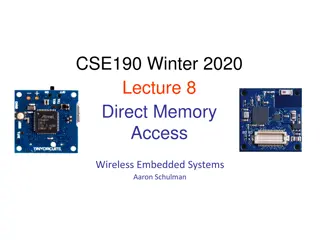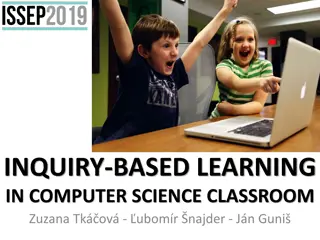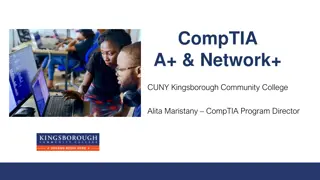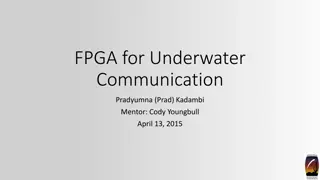Rescue Drone: Increasing Autonomy and Implementing Computer Vision
Focuses on developing a rescue drone with increased autonomy and implementing computer vision for advanced object detection. The team, consisting of Cody Campbell (Hardware Engineer), Alexandra Borgesen (Computer Engineer), Halil Yonter (Team Leader), Shawn Cho (Software Engineer), Peter Burchell (M
78 views • 44 slides
Computer Components and Microprocessor: Understanding Computer Architecture
Explore the main computer components and learn about the operation of these components, including inputting, storing, processing, outputting, and controlling. Understand the role of the microprocessor in computer processing and its characteristics such as instruction set, bandwidth, and clock speed.
11 views • 20 slides
Role of Computer Science in Modern Society
Computer science plays a crucial role in various sectors of life, from business to education. It encompasses a wide range of disciplines, including software development, hardware engineering, system designing, networking, and database administration. The field's scope extends beyond traditional comp
1 views • 20 slides
EMPLOYABILITY SKILLS. INFORMATION & COMMUNICATION TECHNOLOGY SKILLS
ICT skills are crucial for modern life, enabling individuals to communicate, access information, and use technology effectively. This article explores the importance of ICT skills in the workplace and at home, covering tools like smartphones, tablets, TV, radio, and applications. It also delves into
1 views • 23 slides
Computer Peripherals and Interfacing
Computer peripherals are external devices that enhance the functionality of a computer. They include input devices like keyboards and mice, output devices like printers and monitors, and storage devices like hard disk drives and solid-state drives. Interfacing circuits connect these peripherals to t
1 views • 6 slides
Understanding Computer Organization and Architecture
A computer system is a programmable digital electronics device that processes data as per program instructions to provide meaningful output. It comprises hardware and software components, with hardware being the physical parts and software essential for driving the hardware. Computer organization fo
14 views • 71 slides
Understanding Data Transfer and Interfacing in Computer Systems
Data transfer in computer systems involves interfacing between the central processing unit (CPU) and various peripherals such as keyboards, CRT terminals, and cassette tapes. This process enables the exchange of information between internal storage and external input/output (I/O) devices. Interface
6 views • 70 slides
Development of Open Source Extension for Microcontrolled Systems with Scratch Approach in Educational Robotics
In the era of technological advancements, integrating programming concepts into educational contexts is crucial. This project focuses on developing an open-source code extension for microcontrolled systems using Scratch, emphasizing educational robotics. It aims to establish communication between mi
6 views • 34 slides
Explore the World of Computer Graphics in CSE452
Dive into the fascinating realm of computer graphics with CSE452. Learn about modeling, rendering, animation, and its various applications in entertainment, design, education, and more. Discover the techniques of computer-aided design, 3D scanning, procedural modeling, and rendering for photorealist
12 views • 24 slides
Overview of Computer Hardware Components and Software Functions
Computer hardware components such as monitor, CPU, mouse, and projector are essential physical parts of a computer system, while software includes intangible programs like operating systems and utility software. Hardware components perform tasks like displaying data, processing information, and prin
8 views • 9 slides
Understanding Microcontrollers: Definition, Working, and Elements
A microcontroller (MCU) is a compact integrated circuit essential for embedded systems, controlling specific operations. This article delves into the definition, functioning, and key elements of microcontrollers, such as the processor, memory, and I/O peripherals. Explore how microcontrollers work,
0 views • 16 slides
Understanding Interrupts in Embedded Systems
In embedded systems, interrupts play a crucial role in letting peripherals notify the CPU of state changes. They are events external to the current process that disrupt the normal flow of instruction execution, typically generated by hardware devices. By using interrupts, CPUs can efficiently handle
1 views • 12 slides
Understanding Computer Architecture and Organization
Computer architecture and organization are fundamental aspects of computing systems. Computer architecture focuses on the functional design and implementation of various computer parts, while computer organization deals with how operational attributes come together to realize the architectural speci
3 views • 40 slides
Understanding Computer System and Organization
Computer Organization involves the logical structure of a computer, defining the interconnections of components for optimal performance. Computers process data through an Input-Process-Output cycle, with input, processing, and output units working together. The characteristics of a computer include
1 views • 20 slides
Understanding Computer System Buses: Components and Functions
A computer system comprises three main components - the CPU, memory unit, and I/O devices connected via an interconnection network, facilitated by the system bus. System buses reduce communication pathways, enabling high-speed data transfer and synchronization between components. Internal buses conn
3 views • 55 slides
Understanding Direct Memory Access (DMA) in Embedded Systems
Direct Memory Access (DMA) plays a crucial role in transferring large blocks of data efficiently in embedded systems. This technology allows data to be moved between peripherals and main memory without continuous processor intervention, enhancing speed and reducing CPU overhead. By offloading data t
1 views • 16 slides
Computer Science Department Information and Courses Offered
The Computer Science Department provides information on courses offered for GCSE or BTEC qualifications, specifically focusing on the AQA GCSE in Computer Science. The course equips students with valuable thinking and programming skills essential in the modern workplace, covering key concepts and pr
3 views • 7 slides
Comparison of SPI and I2C Communication in Embedded Systems
SPI and I2C are two common communication protocols used in embedded systems. SPI offers fast and easy point-to-point connections with no addressing needed, while I2C allows connecting multiple peripherals with just two wires. SPI has pros such as fast data transfer but cons like complexity with mult
1 views • 17 slides
Anatomy of a Computer System: Hardware Components and Functions
A typical computer system consists of hardware and software working together to perform various computational tasks. The hardware components include the central processing unit (CPU), input/output devices, storage units, and the motherboard. The CPU acts as the main brain of the computer, performing
6 views • 6 slides
Understanding Computer Processing Systems
Computer processing systems consist of various components such as the control unit, ALU, input unit, CPU, output unit, memory, and more. Input devices feed raw data to the computer, while output devices provide processed information. The CPU plays a crucial role in executing instructions and data pr
0 views • 13 slides
Understanding Physical Network Topologies
Physical network topology refers to the layout of cables, computers, and peripherals in a network, distinct from logical topology. Common physical topologies include Star, Ring, Linear Bus, Tree, and Mesh. Each topology has its advantages and disadvantages, impacting network performance and reliabil
0 views • 16 slides
Understanding Microcontrollers: A Comprehensive Overview
Microcontrollers, like the Samd21, Samd51, and ATmega2560, are essential components in electronic systems, featuring processors, memory units, and peripherals. Learn about their history, applications in automobiles and medical devices, as well as how they work and their structure. Explore the role o
5 views • 14 slides
**Exploring Inquiry-Based Learning in Computer Science Education**
Inquiry-based learning (IBL) in computer science classrooms focuses on fostering communication, collaboration, decision-making, and problem-solving skills among students. The approach involves students constructing knowledge through independent, active activities based on real-world experiences. How
0 views • 18 slides
Evolution of Algorithms and Computer Science Through History
The history of algorithms and algorithmic thinking dates back to ancient times, with the development of general-purpose computational machines by Charles Babbage in the 19th century marking a significant advancement. The term "computer science" emerged in 1959, encompassing theoretical computer scie
1 views • 39 slides
CompTIA Program at CUNY Kingsborough Community College
The CompTIA Program at CUNY Kingsborough Community College is a free online training program funded by the U.S. Department of Labor. It aims to prepare students for the CompTIA certification exam and train them to become Computer Support Technicians. The program offers internship opportunities and e
0 views • 10 slides
Overview of Computer Peripherals and Input Technology
Computer peripherals encompass various input and output devices integral to a computer system beyond the CPU. This includes pointing devices like mice, styluses, trackballs, touchpads, touchscreens, light pens, and speech recognition systems. These technologies enhance user interaction, offering mor
0 views • 13 slides
Overview of Computer Input and Output Devices
Input devices of a computer system consist of external components like keyboard, mouse, light pen, joystick, scanner, microphone, and more, that provide information and instructions to the computer. On the other hand, output devices transfer information from the computer's CPU to the user through de
0 views • 11 slides
Solar Energy Generator Design Rendering and Prototype Details
Solar Energy Generator design includes a prototype system mounted in a Pelican case with various peripherals. The system features a Laser Cut Delrin Panel covering all electronics with display, buttons, and a rotary encoder. External connections are facilitated through Souriau UTS circular connector
0 views • 7 slides
NE150 Installation Guide for USB-C Peripherals
Learn how to install USB-C peripherals such as the CT1505, route cables, mount the base using adhesive or non-slip pads, and securely attach a tablet with detailed step-by-step instructions and illustrations.
0 views • 8 slides
Understanding Computer Graphics: An Overview
Computer graphics involves creating images and animations using a computer through hardware and software systems. It has evolved significantly over the years, with advancements in generating various types of computer graphics. Learn about the basics of computer graphics, including digital image repr
0 views • 15 slides
Understanding Computer Crimes and Prevention Strategies
Computer crimes involve illegal acts utilizing computer systems, leading to various consequences. This lecture covers the types of computer system attacks, motives behind computer crimes, costs, prevention strategies, and reflection on the discussed topics. It emphasizes the increasing scope of comp
1 views • 20 slides
Understanding Computer Architecture and Input/Output Systems
Explore the world of computer architecture, input/output systems, external devices, I/O modules, and the challenges of I/O processing. Learn about the functions, structures, and interfaces involved in handling data transfer between CPU, memory, and peripherals. Discover the evolution of I/O function
1 views • 65 slides
Understanding System on Chip (SoC) Design and Components
Explore the world of System on Chip (SoC) design, components, and working flow. Learn about Intellectual Properties (IP), platform-based design, typical design flows, top-down design approach, and the emerging Electronic System Level (ESL) design flow. Discover the essential components of an SoC, su
0 views • 45 slides
Understanding User and Group Permissions in Linux Systems
Linux uses user and group permissions to control access to files, directories, and peripherals. Users are managed for security purposes by limiting access, with the root user having full system access. Grouping users into groups with specific access grants can enhance security. Each file is owned by
0 views • 23 slides
Wireless Office Docking Model for Multiple Devices
This document outlines a usage model for office docking involving wireless connections between mobile devices and various peripheral devices such as monitors, hard drives, printers, and more. It describes scenarios for single and multiple devices in both home and office settings, emphasizing the nee
0 views • 5 slides
Understanding Timers and Time Tracking in Embedded Systems
Explore the importance of timers in embedded systems for tracking time, managing interrupts, and ensuring accurate timekeeping. Learn about different peripherals used, such as real-time clocks and processor timers, to handle tasks like updating UI elements, triggering alarms, and measuring intervals
0 views • 24 slides
Overview of Computer Science at Al Mustaqbal University College of Dentistry
Al Mustaqbal University College of Dentistry offers courses in computer science, covering topics like data reception, processing, storage, and output. The curriculum includes the study of computers as electronic devices, data and information, computer features, operating systems like Windows, and ta
0 views • 10 slides
Understanding the Essence of Computer Science and Computational Thinking
Delve into the fundamentals of Computer Science and Computational Thinking through chapters discussing the nature of science, predictions in physics, and the distinction between Computer Science and Computer Information Systems. Explore the relationships between Math, Physics, and Computer Science i
0 views • 29 slides
Maximize Your Connectivity with Cadyce's Versatile Port Hub
Unlock the full potential of your devices with Cadyce's innovative port hub. This essential accessory expands your connectivity options, allowing you to connect multiple peripherals effortlessly. Whether you need to link a keyboard, mouse, external d
4 views • 5 slides
FPGA for Underwater Communication Project Overview
This project, led by Pradyumna (Prad) Kadambi with mentor Cody Youngbull, aims to develop a robust high-speed underwater communication system using Field Programmable Gate Arrays (FPGA). The project addresses the slow and cumbersome nature of current underwater communication methods, with a focus on
0 views • 9 slides






































